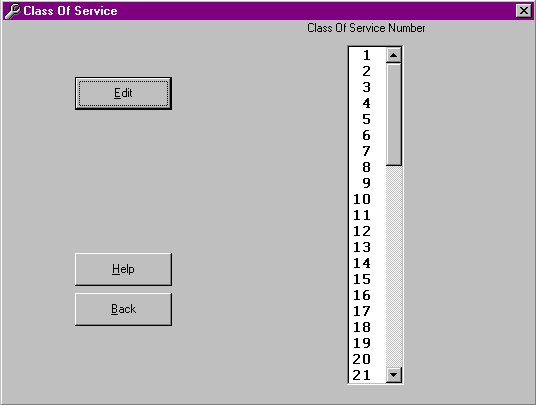PMc Software |
|
|
Mailbox Class of Service Editing
Class of Service is used for each mailbox to
determine the level of service that each mail box has. Such things as the maximum number
of messages and the maximum recording time are items that can be set for each Class of
Service.
Selecting the Class of ServiceFrom the Main Screen (Picture 6) click the Class Of Service button and the following screen will appear. Picture 16: Class of Service selections
Editing the Class of ServiceTo edit a class of service click on the class of service number then click the Edit button. (You can also double click on the number to start editing.) Picture 17 will be displayed.Picture 17: Class of Service Editing
Class of Service items are grouped into four catagories. Click on the tab for each category and make the modifications you require. See the on-line help for details on each of the settings. When you are satisfied with the setting click OK. To exit without changing click the Cancel button. Class of Service Definitions:The class of service tabs is defined below.Mailbox Tab Mailbox Message Capacity: Specifies the maximum number of messages that a mailbox can hold at any one time. This includes both new and saved messages Mailbox Time Capacity: Specifies the total amount of time for messages (both new and saved) allowable in one mailbox. Personal Greeting Length: Defines the available length of Personal Greeting message, which can be recorded by the subscriber. This parameter applies to No-Answer, Busy and After Hours messages. Direct Mailbox Access: When checked the subscriber enters the mailbox by simply calling a Voice Mail extension from his or her own extension. There is no need to dial the subscriber service access code (* + mailbox number). However, password entry is still required if it was specified beforehand. NOTE: This feature is only available if D-PITS Voice Mail Integration with a Panasonic KX-TD series telephone system is activated. Message Tab New Msg Retention Time: Defines the number of days a new message (ie an unplayed message) can remain in the mailbox. The days are counted from the next day of the recording. Saved Message Retention Time: Defines the number of days a saved message (ie a played message) can remain in the mailbox. The days are counted from the next day of the first message playback. If "0" is selected then the saved messages will remain in the mailbox until they are erased by the subscriber. Maximum Message Length: Defines the maximum length of one message that callers can leave in the mailbox. Message Retrieval Order: Specifies the order in which messages are retrieved. LIFO (Last In First Out) Messages are played back from the newest to the oldest. FIFO (First In First Out) Messages are played back from the oldest to the newest. Message Scanning with Information: When checked the voice mail appends the message sender’s name, the recording date and the time to the message during message scan. Message Cancel for Live Call Screening: With the Live Call Screening feature, the subscriber can monitor a message being recorded Authorisation Tab Message Notification: When checked, subscribers can utilise the Message Waiting Notification feature. When this feature is activated three other options are displayed.
External Message Delivery: Allows the subscriber to utilise the External Message Delivery feature. When this feature is activated one option is displayed.
Auto Forwarding: Forwards messages to another mailbox if they have not been listened to for a specific length of time. When this feature is enabled three other options are displayed.
Prompt & Paging Tab Prompt Mode: Specifies the language of voice prompts that the Voice Mail broadcasts to the subscriber during a Message Waiting Notification call and subscriber service. Note: If User 1 or User 2 is specified as Prompt Mode but not recorded by the message manager, the Voice Mail automatically broadcasts the factory recorded system prompts (English) to the subscriber. By default both User 1 and User 2 prompts are not recorded. Intercom Paging Group: Specifies the intercom paging group number available to the subscriber. Note: This feature is available if D-PITS Voice Mail Integration with a Panasonic KX-TD series telephone system is activated. Prompt After Greeting: If checked the Voice Mail broadcasts the following guidance for the message recording to the caller after the personal greeting. "To end recording, hang-up or press [1] for more features. To pause and restart recording press [2]"
|
|
|